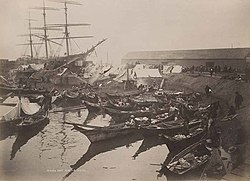Ballast Island | |
 Native American camp on Ballast Island, c. 1890 | |
| Location | Central Waterfront, Seattle, Washington, US |
|---|---|
| Coordinates | 47°36′02″N 122°20′10″W / 47.60056°N 122.33611°W |
| Area | 2.91 acres (1.18 ha) |
| Built | c. 1880 |
| Demolished | 1898 |
| NRHP reference No. | 100006067 |
| Added to NRHP | January 27, 2021 |
Ballast Island was a small artificial island located on the Seattle Waterfront during the late 1800s. Frequent illegal dumping of ballast led to the designation of a specific region of the Seattle harbor where dumping was permitted. Emerging above the surface around 1880, it grew rapidly following additional dock developments in 1881 which largely encircled the island. It became an encampment site and refuge for Native American migrant workers from across the North Pacific coast, many of whom were employed seasonally as hop pickers. They were later joined by refugees of the city's indigenous Duwamish, following the destruction of a West Seattle village by white vigilantes. It additionally became a beacon for tourists, interested in seeing the native camps.
Although encampments were more tolerated on the island than in other areas in the city, the native workers were increasingly viewed as squatters by local press. The Seattle Police Department repeatedly attempted to evict the occupants of the island during the 1890s, although were only able to clear the island for limited periods. Dock, road, and warehouse expansion ended native residence on the island in 1898. The island was eventually subsumed by fill during rail expansion in the 1900s, with much of the former island now lying several meters beneath various modern developments, including Alaskan Way. The boring of the SR 99 tunnel raised concerns that the site of the island would be disturbed, although state archaeological testing later confirmed that the island was not impacted by the project. It was listed on the National Register of Historic Places in 2021.